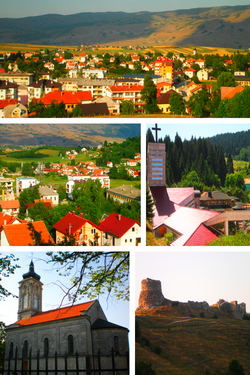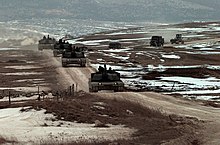Glamoč
Glamoč
Гламоч | |
|---|---|
 From upper left: Panoramic view of Glamoč, panoramic view of Lamele and Luke neighbourhoods,Catholic church of Saint Elias,Orthodox church,Fortress | |
 Location of Glamoč within Bosnia and Herzegovina | |
| Coordinates:44°02′42″N16°51′00″E/ 44.04500°N 16.85000°E | |
| Country | Bosnia and Herzegovina |
| Entity | Federation of Bosnia and Herzegovina |
| Canton | Canton 10 |
| Area | |
| • Total | 16.88 km2(6.52 sq mi) |
| Population (2013) | |
| • Total | 1,885 |
| Time zone | UTC+1(CET) |
| • Summer (DST) | UTC+2(CEST) |
| Area code | +387 34 |
Glamoč(Serbian Cyrillic:Гламоч) is a town and the seat of theMunicipality of GlamočinCanton 10of theFederation of Bosnia and Herzegovina,an entity ofBosnia and Herzegovina.It is situated in southwestern Bosnia and Herzegovina, at the foothills ofStaretinaandVelika Golijamountains, and on the edge of the central part of theGlamočko Polje.
Name[edit]
During theOttomanera the town was recorded as Biograd (White town), Belgradčik and Biogradaz.[2]
Geography[edit]
Climate[edit]
The climate of Glamoč is classified as anoceanic climate(CfbinKöppen climate classification system), near the boundary of thehumid continental climate.Glamoč has four separateseasons.Summers are warm, and winters are cold, without a discernibledry season.
| Climate data for Glamoč | |||||||||||||
|---|---|---|---|---|---|---|---|---|---|---|---|---|---|
| Month | Jan | Feb | Mar | Apr | May | Jun | Jul | Aug | Sep | Oct | Nov | Dec | Year |
| Mean daily maximum °C | 0.7 | 2.6 | 6.6 | 11.4 | 16.5 | 20.2 | 22.7 | 22.4 | 18.3 | 12.2 | 6.7 | 2.5 | 11.9 |
| Daily mean °C | −1.8 | −0.6 | 2.8 | 6.9 | 11.6 | 15.2 | 17.3 | 16.9 | 13.3 | 8.3 | 3.8 | 0.1 | 7.8 |
| Mean daily minimum °C | −4.2 | −3.8 | −1 | 2.5 | 6.8 | 10.2 | 11.9 | 11.4 | 8.3 | 4.5 | 1 | −2.3 | 3.8 |
| Averageprecipitationmm | 81 | 85 | 80 | 85 | 86 | 98 | 72 | 71 | 77 | 101 | 139 | 138 | 1,113 |
| Mean daily maximum °F | 33.3 | 36.7 | 43.9 | 52.5 | 61.7 | 68.4 | 72.9 | 72.3 | 64.9 | 54.0 | 44.1 | 36.5 | 53.4 |
| Daily mean °F | 28.8 | 30.9 | 37.0 | 44.4 | 52.9 | 59.4 | 63.1 | 62.4 | 55.9 | 46.9 | 38.8 | 32.2 | 46.1 |
| Mean daily minimum °F | 24.4 | 25.2 | 30 | 36.5 | 44.2 | 50.4 | 53.4 | 52.5 | 46.9 | 40.1 | 34 | 27.9 | 38.8 |
| Averageprecipitationinches | 3.2 | 3.3 | 3.1 | 3.3 | 3.4 | 3.9 | 2.8 | 2.8 | 3.0 | 4.0 | 5.5 | 5.4 | 43.7 |
| Source:[3] | |||||||||||||
History[edit]

The Glamoč area has been inhabited since at leastNeolithictimes. In the lateBronze Age,the Neolithic population was replaced by more warlikeIndo-Europeantribes known as theIllyrians,specifically theDalmatae.Their capital wasDelminium,which was located in today'sTomislavgrad.The Dalmatae left many artefacts which allow us to learn about their presence in this area. The most important remains are thegradine,remains of Illyrian settlements which were distributed along the Glamoč field. 34 gradinas were found on the territory of Glamoč.[4]The settlements were strategically placed for defence. TheRomanstook over 200 years to occupy this region.
After the Roman conquest,municipiawas established in this area, which was located in theRoman province of Dalmatia.The most important of them wasSalvium,which was previously an Illyrian settlement. Salvium is located 6 km away from the town of Glamoč. Anearly Christianbasilicawas discovered on the territory of Salvium. It was built in the 6th century, probably on the remains of a Roman temple.[5]North of Glamoč, a second basilica was built, probably at the same time as the aforementioned basilica in Salvium was built. These basilicas belonged to the diocese ofSalona.In 533, they became part of the newly established diocese in Ludrum (Knin,Croatia). The basilicas were probably destroyed during the invasion of theAvarsin 597.[5]

With the collapse of Roman rule in the 5th century, firstbarbarian tribesand then theByzantine Empireoccupied this region. In the seventh century,South Slavsmigrated to the Balkan region. They broughtSlavic cultureand customs which gradually merged with the Illyrian culture. The community was granted the status ofparish (župa)in the County of Hlivno afterTomislavestablished theKingdom of Croatiain 925. Therefore, the town, by the end of the 10th century, had developed all the infrastructure necessary for acquiring the status of the parish. In 1078 it was mentioned as a boundary parish ofArchdiocese of Split.[6]
A church, dedicated to theVirgin Marywas built.[7]Near the town, the church of St. Catherine and theFranciscanMonastery ofSt. Eliaswas built.[8]Within the monastery, the Church of theAssumption of the Blessed Virgin Marywas located. The church was mentioned in 1446 whenPope Eugene IVcommended it in particular.[9]The remains of the[clarification needed]were found in several surrounding villages which indicates the dense population of the area.Bosnian banStjepan II Kotromanićconquered Glamoč and neighbouring towns, Hlivno (Livno) and Dlmno (Tomislavgrad) in 1326. Since then, this area has been calledTropolje,meaning three fields, orZavršje.Until 1357, Glamoč was a possession of theHrvatinić noble family.[10]
In 1357, Bosnian banTvrtko Isuccumbed to Hungarian demands and ceded Tropolje to theHungarian kingLouis I the Great.That same year, Grgur Stjepanić was mentioned as Lord of Glamoč. He, along with other nobles of Tropolje, rebelled against Tvrtko, so Glamoč remained under Hungarian rule until 1387. In the meantime, Tvrtko was crowned as theKing of Bosniaand with the help ofHrvoje Vukčić Hrvatinićhe regained the area. At the end of the 14th century, Pavao Maštrović Klešić became Lord of Glamoč. Bosnian KingStjepan Ostojatook his lordship, but when he needed Pavao as an ally he returned it to him in 1404.[2]

Glamoč fell under Ottoman rule in the year 1515. In 1516, it was mentioned as anahiyeDlamoč or Belgrad in the kadilukofNeretva.It remained a part of theBosnia Sanjakuntil 1537. In 1550 and 1574 it was recorded as a nahiye in theSkradinkadiluk in theSanjak of Klis.AfterKliswas liberated in 1648, Glamoč became part of the Livno kadiluk.[2]
During the Ottoman period the town was calledBiogradorBelgradčik.It was recorded under this name until 1833. A Venetian-Dalmatian source from the first half of the 17th century recorded thatBiogradazwas a fortress with several towers. In the second half of the 18th century, it was noted that the town lies along theDalmatianborder, and that it is well fortified, but that it has little artillery. The fortress was abandoned in 1851 and partially demolished in 1882.[2]

In 1878, with theCongress of Berlin,Bosnia and Herzegovina, including Glamoč, came underAustro-Hungarian rule.Complete annexation followed in 1908. Administratively, the town was located in the Travnik District. At that time, a significant number of Catholics, mostly from Dalmatia, immigrated,[6]so the Catholic church ofSaint Eliaswas built in 1903.[citation needed]
After the end ofWorld War Iand the dissolution ofAustria-Hungary,the province of Bosnia and Herzegovina, along with Glamoč, became a part of theState of Slovenes, Croats and Serbsand soon thereafterKingdom of Serbs, Croats and Slovenes.After theVidovdan Constitutionof 1921 established new administrative divisions, the town became part Travnik County. The country changed its name to theKingdom of Yugoslaviain 1929, and then Glamoč became part of a new administrative unit,Vrbas Banovina.
On 9 January 1992, theBosnian SerbAssemblyadopted the Proclamation of theRepublic of the Serb people of Bosnia and Herzegovina.[citation needed]On 28 February 1992, theConstitution of Republika Srpskawas adopted and declared that the state's territory included Serb autonomous regions, municipalities, and other Serbian ethnic entities in Bosnia and Herzegovina, including Glamoč, where Bosnian Serbs were 79% of the population.[citation needed]
In early 1992, manyBosniaksandBosnian Croatsleft Glamoč. Those who remained suffered at the hands of the Serb forces.[11]An early victim was a Croatian physician, Dr Alojzije Kelava, who was murdered in the city centre on 24 February 1992 by Petar Vrakela, member of theArmy of Republika Srpska(VRS).[12]

Shortly thereafter, Serbian forces startedethnic cleansingof the non-Serb population and the destruction of the Bosnian-Herzegovinian cultural and historical heritage. In 1992, theCatholic church,the rectory and the town's mosque were destroyed.[13]The parish priest of Glamoč, Rev. Zvonimir Matijević, was arrested and taken toKninprison where he was tortured.[12]
From Glamoč field, Serbs besieged and bombarded the nearby town ofLivno.By early 1995, most of the non-Serb population had left the municipality. On 25 July 1995,HVandHVObeganOperation Summer '95.In the next few days, a large part of the Serb population left Glamoč, led by the VRS. On 29 July, HVO troops attacking from the south captured the town.[14][15]
Soon, the area was inhabited by refugees fromRepublika Srpskaand centralBosnia.Some remained in Glamoč. Meanwhile, some of the Croats andBosniakswho had left Glamoč at the beginning of the war and Serbs who left Glamoč after the Croatian Army captured it have returned. After the signing of theDayton Agreement,Glamoč became a municipality ofCanton 10,Federation of Bosnia and Herzegovina.The war has caused economic and demographic decline of the municipality. Large funds are dedicated in the reconstruction of destroyed infrastructure, but the area is still underdeveloped.[citation needed]
Demographics[edit]
Nationalities structure, according to the 2013 census
Ethnic composition[edit]
| Ethnic composition – Glamoč town | |||||||
|---|---|---|---|---|---|---|---|
| 2013. | 1991. | 1981. | 1971. | 1961. | |||
| Total | 1,885 (100,0%) | 4,256 (100,0%) | 3,777 (100,0%) | 2,597 (100,0%) | 1,626 (100,0%) | ||
| Croats | 762 (40,42%) | 43 (1,010%) | 52 (1,377%) | 85 (3,273%) | 65 (3,998%) | ||
| Serbs | 556 (29,50%) | 3,254 (76,46%) | 2,686 (71,11%) | 1,701 (65,50%) | 846 (52,03%) | ||
| Bosniaks | 549 (29,12%) | 852 (20,02%) | 809 (21,42%) | 758 (29,19%) | 450 (27,68%) | ||
| Others | 18 (0,955%) | 16 (0,376%) | 9 (0,238%) | 15 (0,578%) | 4 (0,246%) | ||
| Yugoslavs | 91 (2,138%) | 213 (5,639%) | 23 (0,886%) | 251 (15,44%) | |||
| Montenegrins | 4 (0,106%) | 5 (0,193%) | 6 (0,369%) | ||||
| Albanians | 3 (0,079%) | 9 (0,347%) | 2 (0,123%) | ||||
| Macedonians | 1 (0,026%) | 1 (0,039%) | 1 (0,062%) | ||||
| Slovenes | 1 (0,062%) | ||||||
Notable people[edit]
- Miroslav Čangalović,opera singer
- Todor Petrović,footballer
- Obrad Piljak,politician
- Pavao Posilović,Roman Catholic bishop and writer
- Stojan Srdić,writer
- Zdravko Tolimir,commander in the Army of Republika Srpska
- Zaim Topčić,writer
- Vule Trivunović,footballer
- Slavko Zagorac,retired footballer and manager
Other[edit]
- Ivo Lola Ribar,Yugoslav communist was killed near Glamoč by airstrike
See also[edit]
References[edit]
- ^Postcode info for Bosnia-Herzegovina
- ^abcd"Stari grad Glamoč, graditeljska cjelina".kons.gov.ba(in Bosnian). Commission to Preserve National Monuments. Archived fromthe originalon 1 March 2014.Retrieved18 August2013.
- ^"Climate data for cities worldwide".RetrievedFebruary 7,2013.
- ^(in Croatian)Bosnia and Herzegovina, Commission to Preserve National Monuments, Old City (Glamoč)Archived2014-03-01 at theWayback Machine
- ^ab(in Croatian)Bosnia and Herzegovina, Commission to Preserve National Monuments, Remains of early Christian basilicaArchived2014-07-14 at theWayback Machine
- ^ab"Glamoč details".hbzup.com(in Croatian). Tourism Board of Canton 10. Archived fromthe originalon 10 October 2015.Retrieved25 September2015.
- ^Desanka Kovačević-Kojić (1978).Gradska naselja srednjovjekovne bosanske države (Urban settlements of Medieval Bosnian State.Sarajevo: Veselin Masleša.
- ^"Župa Glamoč (Glamoč Parish)".biskupija-banjaluka.org(in Croatian).Roman Catholic Diocese of Banja Luka.Archived fromthe originalon 22 May 2013.Retrieved18 August2013.
- ^"Kratka povijest provincije (Short History of the Province)".franjevci.info(in Croatian). Franciscan Province of the Assumption of the Blessed Virgin Mary. Archived fromthe originalon 22 July 2013.Retrieved18 August2013.
- ^"Glamoč details".hebeta.lzmk.hr(in Croatian). Leksikografski zavod Miroslav Krleža (Miroslav Krleža Institute of Lexicography). Archived fromthe originalon 25 September 2015.Retrieved25 September2015.
- ^"New War Crimes Verdicts in Bosnia".balkaninsight.com.Balkan Transitional Justice. 22 June 2012.Retrieved12 August2013.
- ^abFranjo Komarica."IN DEFENCE OF THE RIGHTLESS".hic.hr.Retrieved12 August2013.
- ^Andras Riedlmayer (30 September 2003)."Glamoc Abandoned".bosnia.org.uk.Bosnian Institute. Archived fromthe originalon 23 September 2015.Retrieved12 August2013.
- ^Central Intelligence Agency,Office of Russian and European Analysis (2002).Balkan Battlegrounds: A Military History of the Yugoslav Conflict, 1990–1995.Washington, D.C.: Central Intelligence Agency.ISBN9780160664724.OCLC50396958.
- ^A Military History of the Yugoslav Conflict, 1990–1995 details,nato.int, 2003.


